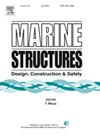基于局部共振的CFRP筏架低频减振研究
IF 5.1
2区 工程技术
Q1 ENGINEERING, CIVIL
引用次数: 0
摘要
随着对增强船舶隐身性能的需求不断增长,对浮筏框架系统有效隔振的需求增加,特别是在低频范围内。筏架在整体减振性能中起着至关重要的作用。为提高筏架的低频减振性能,将筏架局部共振的低频弹性波调制特性和碳纤维增强塑料(CFRP)的高阻尼特性结合到筏架中,通过试验平台对筏架的振动特性进行了研究。采用B&;K测试系统,研究了不同振子分布和质量对CFRP筏架振动性能的影响。结果表明,振荡器的加入降低了初始振动衰减频率,最大振动衰减从48.9 dB提高到103.2 dB。通过将振荡器放置在低频衰减的支撑位置和高频衰减的中心位置,实现了最佳的减振效果。这种空间分布策略与模拟预测一致。综上所述,将局部共振的低频调制特性融入CFRP筏架中,可以显著提高筏架的减振性能。本文章由计算机程序翻译,如有差异,请以英文原文为准。
Low frequency vibration reduction of CFRP raft frame based on local resonance
As the demand for enhanced ship stealth performance continued to grow, the need for effective vibration isolation in the floating raft frame system, particularly within the low-frequency range, was increased. The raft frame played a critical role in determining the overall vibration-reduction performance. To improve the low-frequency vibration reduction, this paper incorporated the low-frequency elastic wave modulation characteristics of local resonance and the high damping properties of Carbon Fiber Reinforced Plastics (CFRP) into the raft frame, investigating their vibration characteristics via a test platform. Different oscillator distributions and masses were applied to the CFRP raft frame to study their effects on vibration behavior, with measurements taken using the B&K test system. The results revealed that the addition of oscillators lowered the initial vibration attenuation frequency and increased the maximum vibration attenuation from 48.9 dB to 103.2 dB. Optimal vibration reduction was achieved by placing the oscillators at the support position for low-frequency attenuation and at the center position for high-frequency attenuation. This spatial distribution strategy demonstrated agreement with simulation predictions. In conclusion, integrating the low-frequency modulation characteristics of local resonance into the CFRP raft frame significantly enhanced its vibration-reduction performance.
求助全文
通过发布文献求助,成功后即可免费获取论文全文。
去求助
来源期刊

Marine Structures
工程技术-工程:海洋
CiteScore
8.70
自引率
7.70%
发文量
157
审稿时长
6.4 months
期刊介绍:
This journal aims to provide a medium for presentation and discussion of the latest developments in research, design, fabrication and in-service experience relating to marine structures, i.e., all structures of steel, concrete, light alloy or composite construction having an interface with the sea, including ships, fixed and mobile offshore platforms, submarine and submersibles, pipelines, subsea systems for shallow and deep ocean operations and coastal structures such as piers.
 求助内容:
求助内容: 应助结果提醒方式:
应助结果提醒方式:


